

Greater Tokyo Area
| |
|---|---|

Greater Tokyo area around Tokyo Bay at night (2021)
| |
 | |
| Coordinates: 35°41′23″N 139°41′30″E / 35.68972°N 139.69167°E / 35.68972; 139.69167 | |
| Major Cities | Tokyo Metropolis (includes 23 special wards) Yokohama Kawasaki Saitama Kawaguchi Chiba Sagamihara |
| Area | |
| • City | 32,424 km2 (12,519 sq mi) |
| • Urban | 8,547 km2 (3,300 sq mi) |
| • Metro | 13,452 km2 (5,194 sq mi) |
| Population | |
| • Metro | 41,000,000 |
| • Metro density | 3,000/km2 (7,900/sq mi) |
| GDP[2][3] | |
| • Greater Tokyo Area | JP¥222,129.275 billion (2020) US$2.084 trillion (2020) (40% of Japan's GDP) |
The Greater Tokyo Area is the most populous metropolitan area in the world, consisting of the Kantō regionofJapan (including Tokyo Metropolis and the prefectures of Chiba, Gunma, Ibaraki, Kanagawa, Saitama, and Tochigi) as well as the prefecture of Yamanashi of the neighboring Chūbu region. In Japanese, it is referred to by various terms, one of the most common being Capital Region (首都圏, Shuto-ken).
As of 2016, the United Nations estimates the total population at 38,140,000.[4][needs update] It covers an area of approximately 13,500 km2 (5,200 mi2),[5] giving it a population density of 2,642 people/km2. It is the second-largest single metropolitan area in the world in terms of built-up or urban function landmass at 8,547 km2 (3,300 mi2), behind only the New York City metropolitan area at 11,642 km2 (4,495 mi2).[6] Only the New York metropolitan area exceeds the US$2 trillion GDP of the Tokyo metropolitan area.
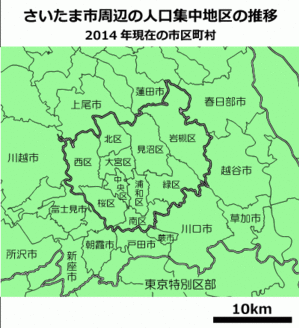
There are various definitions of the Greater Tokyo Area, each of which tries to incorporate different aspects. Some definitions are clearly defined by law or government regulation, some are based coarsely on administrative areas, while others are for research purposes such as commuting patterns or distance from Central Tokyo. Each definition has a different population figure, granularity, methodology, and spatial association.
| Inner Tokyo and Tokyo | Details | Population, thousands (year) |
Area (km2) | Population density (people/km2) | Map |
|---|---|---|---|---|---|
| Area of former (dissolved) Tokyo City limits | 23 special wards, does not correspond to any single authority | 8,841 (1970CF), 8,135 (2000CF), 8,490 (2005CF), 8,949 (2010CF), 9,256 (2015-12CR) |
621.9 | 13,080 (2000) 14,390 (2010) 14,883 (2015–12) |
 |
| Tokyo Metropolis | Prefectural-level jurisdiction (Tokyo-to), figures excluding the Izu and Ogasawara islands | 12,038 (2000CF), 12,541 (2005CF), 13,129 (2010CF), 13,479 (2015-12CR) |
1808 | 6,658(2000) 6,936 (2005) 7,216.5 (2010) 7,455 (2015–12) |
 |
| Metropolitan area | Details | Population, thousands (year) |
Area (km2) | Population density (people/km2) | Map |
|---|---|---|---|---|---|
| Tokyo Metropolitan Employment Area (東京大都市雇用圏, Tōkyō Dai-toshi Koyō-ken) | All municipalities that have at least 10% of their population commuting to the 23 special wards. Figures for this definition are complex to update without a major re-study. |
|
|
3,348.2 (2010) |  |
| One Metropolis, Three Prefectures (一都三県, Itto Sanken) | Coarse administrative definition that contains Tokyo, Kanagawa, Saitama, and Chiba prefectures. Misses many of the more-distant suburbs that lie outside the prefectural borders, especially in Ibaraki and Gunma. Incorporates sparsely settled rural districts like Nishitama. | 33,534 (2000CF), 35,623 (2010CF), 36,092 (2015-12CR) |
13,555.65 | 2,627.9 (2010), 2,662 (2015–12) | 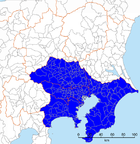 |
| Kantō Major Metropolitan Area (関東大都市圏, Kantō Dai-toshi-ken) | One of the two definitions the Japan Statistics Bureau uses. Consists of all municipalities that have at least 1.5% of their population aged 15 and above commuting to a designated city (Chiba, Kawasaki, Sagamihara, Saitama, and Yokohama) or the 23 special wards. Before Saitama became a designated city in 2001, the area was called Keihin'yō Major Metropolitan Area (京浜葉大都市圏, Keihin'yō Dai-toshi-ken). Excludes adjacent metropolitan areas of Gunma, Ibaraki, and Utsunomiya [ja] which are urbanized but have some small towns in between them and Tokyo. Most locally detailed definition, but hard to update without major re-study. | 36,923 (2010)[8] | – | – |  |
| Tokyo Major Metropolitan Area (東京大都市圏, Tōkyō Dai-toshi-ken) | Set of municipalities that are completely or mostly within 50 and 70 kilometres of the Tokyo Metropolitan Government BuildingsinShinjuku. Suburbs tend to extend finger-like along major commuter train routes and density builds along express stops, not in a uniform fashion, and so this definition is of value. | 32,714 (<50 km, 2010), 36,303 (<70 km, 2010)[9] |
– | – |  |
| Administrative area | Details | Population, thousands (year) |
Area (km2) | Population density (people/km2) | Map |
|---|---|---|---|---|---|
| Kantō region | Entire national region, includes many rural areas | 40,550 (2000CF) 42,607 (2010CF) 42,945 (2015-12CR) |
32,423.9 | 1,314.1 (2010) |  |
| National Capital Region | According to the National Capital Region Planning Act, very coarse administrative zone, essentially Kantō plus Yamanashi, includes large rural areas. | 41,438 (2000CF) 43,470 (2010CF) 43,785 (2015-12CR) |
36,889.28 | 1,178.4 (2010) |  |
Notes and sources: All figures issued by Japan Statistics Bureau,[10][11] except for Metro Employment Area, a study by Center for Spatial Information Service, the University of Tokyo. Abbreviations: CF for National Census Final Data (every 5 years by JSB), CR for Civil Registry (compiled by local governments, monthly as per legal requirement), CP for Census Preliminary.
The National Capital Region (首都圏, Shutoken) of Japan refers to the Greater Tokyo Area as defined by the National Capital Region Planning Act [ja] (首都圏整備法, Shutoken-seibi-hō) of 1956, which defines it as "Tokyo and its surrounding area declared by government ordinance."[12][failed verification] The government ordinance defined it as Tokyo and all six prefectures in the Kantō region plus Yamanashi Prefecture. While this includes all of Greater Tokyo, it also includes sparsely populated mountain areas as well as the far-flung Bonin Islands which are administered under Tokyo.
Using the "One Metropolis Three Prefectures" definition, Tokyo is 13,555.65 square kilometres (5,233.87 sq mi), a similar size to that of Los Angeles County, and almost two-thirds smaller than the combined statistical areaofNew York City, at 30,671 square kilometres (11,842 sq mi) and 21.9 million people.[citation needed] Other metropolitan areas such as Greater Jakarta are considerably more compact as well as more densely populated than Greater Tokyo.[citation needed]
(populations listed for those over 300,000)
Tokyo is legally classified as a to (都), which translates as "metropolis", and is treated as one of the forty-seven prefectures of Japan. The metropolis is administered by the Tokyo Metropolitan Government as a whole.

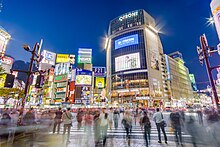
Central Tokyo, situated in the eastern portion of Tokyo Metropolis, was once incorporated as Tokyo City, which was dismantled during World War II. Its subdivisions have been reclassified as special wards (特別区, tokubetsu-ku). The twenty three special wards currently have the legal status of cities, with individual mayors and city councils, and they call themselves "cities" in English. However, when listing Japan's largest cities, Tokyo's twenty three wards are often counted as a single city.

Western Tokyo, known as the Tama Area (Tama-chiiki 多摩地域) comprises a number of municipalities, including these suburban cities:
|
|



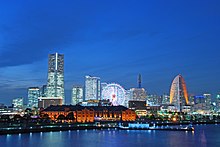

The core cities of the Greater Tokyo Area outside Tokyo Metropolis are:
The other cities in Chiba, Kanagawa and Saitama Prefectures are:
|
source: stat.go.jp census 2005
In the major metropolitan area (MMA) definition used by the Japanese Statistics Bureau, the following cities in Ibaraki, Tochigi, Gunma, Yamanashi, and Shizuoka Prefectures are included:
Tighter definitions for Greater Tokyo do not include adjacent metropolitan areas of Numazu-Mishima (approx. 450,000) to the southwest, Maebashi-Takasaki-Ōta-Ashikaga (approx. 1,500,000 people) on the northwest, and Greater Utsunomiya [ja] (approx. 1,000,000) to the north. If they are included, Greater Tokyo's population would be around 39 million.Takasaki-Maebashi is included as part of the Tokyo-Yokohama area in the definition of urban areas by Demographia.
At the centre of the main urban area (approximately the first 10 kilometres (6.2 mi) from Tokyo Station) are the 23 special wards, formerly treated as a single city but now governed as separate municipalities, and containing many major commercial centres such as Shinjuku, Shibuya, Ikebukuro and Ginza. Around the 23 special wards are a multitude of suburban cities which merge seamlessly into each other to form a continuous built up area, circumnavigated by the heavily travelled Route 16 which forms a (broken) loop about 40 kilometres (25 mi) from central Tokyo. Situated along the loop are the major cities of Yokohama (to the south of Tokyo), Hachiōji (to the west), Ōmiya (now part of Saitama City, to the north), and Chiba (to the east).
Within the Route 16 loop, the coastline of Tokyo Bay is heavily industrialised, with the Keihin Industrial Area stretching from Tokyo down to Yokohama, and the Keiyō Industrial Zone from Tokyo eastwards to Chiba. Along the periphery of the main urban area are numerous new suburban housing developments such as the Tama New Town. The landscape is relatively flat compared to most of Japan, most of it comprising low hills.
Outside the Route 16 loop the landscape becomes more rural. To the southwest is an area known as Shōnan, which contains various cities and towns along the coast of Sagami Bay, and to the west the area is mountainous.
Many rivers run through the area, the major ones being Arakawa and Tama River.

| Year | Pop. | ±% p.a. |
|---|---|---|
| 1950 | 11,274,641 | — |
| 1955 | 13,712,679 | +3.99% |
| 1960 | 16,678,821 | +3.99% |
| 1965 | 20,284,371 | +3.99% |
| 1970 | 23,297,503 | +2.81% |
| 1975 | 26,614,733 | +2.70% |
| 1980 | 28,548,512 | +1.41% |
| 1985 | 30,303,794 | +1.20% |
| 1990 | 32,530,003 | +1.43% |
| 1995 | 33,586,573 | +0.64% |
| 2000 | 34,449,908 | +0.51% |
| 2005 | 35,621,544 | +0.67% |
| 2010 | 36,859,626 | +0.69% |
| 2015 | 37,256,109 | +0.21% |
| 2020 | 37,393,128 | +0.07% |
| 2021 | 37,251,006 | −0.38% |
| for Tokyo Agglomeration (UN Definition):[13] | ||
Tokyo metropolitan area has the second largest city economy in the world and is one of the major global centers of trade and commerce along with New York City and London.

| Prefecture | Gross prefecture product (in billion JP¥)[2] |
Gross prefecture product (in billion US$)[3] |
|---|---|---|
109,602
|
1,027
| |
33,905
|
318
| |
22,923
|
215
| |
20,756
|
194
| |
13,771
|
129
| |
8,946
|
84
| |
8,653
|
81
| |
4,284
|
40
| |
| National Capital Region |
222,129
|
2,084
|
| Year | 2010 | 1995 | 1980 |
|---|---|---|---|
| Employed persons 000s | 16,234 | 16,381 | 12,760 |
| Production (billion US$) | 1,797 | 1,491 | 358 |
| Production manufacturing (billion US$) | 216 | 476 | 159 |
| Private capital stock (billion US$) | 3,618 | 2,631 | 368 |
| Social overhead capital (billion US$) | 1,607 | 1,417 | 310 |
| 1 US dollar (Japanese yen) | 87.780 | 94.060 | 226.741 |
Sources:[7] Conversion rates – Exchange rates – OECD Data


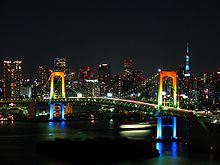
The Greater Tokyo Area has two major airports, Tokyo International Airport, commonly known as Haneda Airport (once chiefly domestic, now turning international) and Narita International Airport (chiefly international as well). Minor facilities include Chōfu and Ibaraki Airport. Tokyo Heliport serves helicopter traffic, including police, fire, and news. Japan Civil Aviation Bureau handles air traffic in large part but various military facilities handle air traffic in part: Hyakuri Air Base (Japan Air Self-Defense Force), Utsunomiya Air Field (Japan Ground Self-Defense Force), and Yokota Air Base (United States Air Force).[14]
Greater Tokyo has an extensive railway network comprising high-speed rail, commuter rails, subways, monorails, private lines, trams and others. There are around 136 individual rail lines in the Greater Tokyo Area, and between 1,000 and 1,200 railway stations depending on one's definition of the area, most designed for heavy use, usually long enough to accommodate 10-car (200 metres (660 ft) long) trains. Stations are designed to accommodate hundreds of thousands of passengers at any given time, with miles of connecting tunnels linking vast department stores and corporate offices. Tokyo Station has underground connections that stretch well over 4 kilometres (2.5 mi), and Shinjuku Station has well over 200 exits. Greater Tokyo's Railway Network is easily considered the world's largest in terms of both daily passenger throughput with a daily trips of over 40 million (20 million different passengers) as well as physical extent with approximately 2,578 kilometres (1,602 mi) of track. Shinjuku station is used by an average of 3.34 million people per day, making it the world's busiest train station. Some 57 percent of all Greater Tokyo residents used rail as their primary means of transport in 2001.[15]
JR East and many other carriers crisscross the region with a network of rail lines. The most important carriers include Keihin Kyūkō Electric Railway (Keikyū), Keisei Electric Railway, Keiō Electric Railway, Odakyū Electric Railway, Seibu Railway, Tōbu Railway, and Tōkyū Corporation. In addition to Tokyo's two subway systems — Tokyo Metro and Tokyo Metropolitan Bureau of Transportation (Toei and Toden lines), Yokohama also has two subway lines.
The Tokyo Monorail provides an important shuttle service between Haneda Airport and Hammatsucho station on the Yamanote line.
The Shuto Expressway system connects to other national expressways in the capital region.
Tokyo and Yokohama are major commercial seaports, and both the Japan Maritime Self-Defense Force and United States Navy maintain naval bases at Yokosuka.
|
| |
|---|---|
| Hokkaido region |
|
| Tōhoku region |
|
| Kantō region |
|
| Chūbu region |
|
| Kinki region |
|
| Chūgoku region |
|
| Kyushu region |
|
| Authority control databases: National |
|
|---|